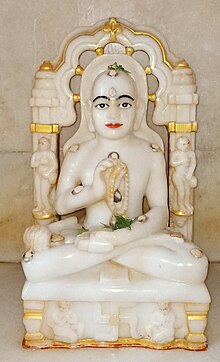Gautama Swami
| Indrabhuti Gautama | |
|---|---|
 An idol of Gautama Swami | |
| Successor | Sudharmaswami |
| Age | 92 |
| Genealogy | |
| Parents |
|
| Part of a series on |
| Jainism |
|---|
 |
Gautama Swami, born as Indrabhuti Gautama was the first Ganadhara (chief disciple) of Mahavira, the 24th and last Jain Tirthankara of present half cycle of time.[1] He is also referred to as Guru Gautama, Gautama Ganadhara, and Ganadhara Gautama Swami.
Life
[edit]Gautama was the senior-most of 11 ganadharas (chief disciples) of Mahavira.[2] He had two brothers Agnibhuti and Vayubhuti who also became ganadhara of Mahavira.[3] Other ganadhara were Vyakta, Sudharmaswami, Mandikata Mauryaputra, Akampita, Acalabharata, Metarya and Prabhasa.[3] A stone pillar of Utaroda mentions Mahagiri as one of Ganadharas of Mahavira who had Utara as his chief disciple.[4]
In Jain traditional accounts, Gautama is believed to have gained Kevala Jnana (omniscience) immediately after the moksha (liberation) of Mahavira.[5] He was succeeded by Sudharmaswami who is believed to have gained omniscience after a further 12 years.[5]

According to the elaboration of Debate with the Ganadhara by Jinabhadra, the learned Brahmin Gautama summoned the gods to a great sacrifice but instead they flew off to hear Mahavira preaching at his second samavasarana near by.[6] In fury, Gautama confronted Mahavira in debate, as did ten other brahmins in succession, with the fordmaker converting them all by a demonstration, underpinned by his claim to omniscience.[6] According to Svetambara texts, Gautama had a meeting with Keśī (ganadhara of Parshvanatha).[7] Svetambaras write Gautama's name in new account books as a sign of auspiciousness in the new year.[8]
Gautama is connected with prosperity as he fed some monks using his magical powers.[8] Gautama is mentioned in the Exposition of Explanations, as an interpreter of Mahavira.[6] It is further mentioned that they have been friends in their previous incarnations and will attain moksha in the one which they are now.[6]
See also
[edit]- Gotama Samana – A Sri Lankan philosopher who is claimed to live over more than 3800 years ago.
References
[edit]Citations
[edit]- ^ Teerthankar mahaveer aur unki acharya parampara by Dr. Nemi chandra shastry, Sagar, 1974 vol-1-4.
- ^ Natubhai Shah 2004, p. 38.
- ^ a b Natubhai Shah 2004, p. 32.
- ^ Vyas 1995, p. 28.
- ^ a b Natubhai Shah 2004, p. 39.
- ^ a b c d Dundas 2002, p. 37.
- ^ von Glasenapp 1925, p. 35.
- ^ a b Dundas 2002, p. 39.
Sources
[edit]- Dundas, Paul (2002) [1992], The Jains (Second ed.), Routledge, ISBN 0-415-26605-X
- Shah, Natubhai (2004) [First published in 1998], Jainism: The World of Conquerors, vol. I, Motilal Banarsidass, ISBN 978-81-208-1938-2
- von Glasenapp, Helmuth (1925), Jainism: An Indian Religion of Salvation [Der Jainismus: Eine Indische Erlosungsreligion], Shridhar B. Shrotri (trans.), Delhi: Motilal Banarsidass (Reprint: 1999), ISBN 978-81-208-1376-2
- Vyas, Dr. R. T., ed. (1995), Studies in Jaina Art and Iconography and Allied Subjects, The Director, Oriental Institute, on behalf of the Registrar, M.S. University of Baroda, Vadodara, ISBN 81-7017-316-7
